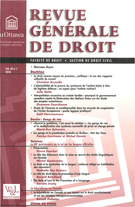Résumés
Résumé
Pendant longtemps, l’action syndicale s’est déployée dans la clandestinité, en marge du droit. Aussi loin que l’on puisse remonter dans l’histoire des relations de travail, le droit criminel et le droit des rapports privés réprouvaient les moyens de pression exercés collectivement par les salariés. Cette situation contribuera dans une large mesure à nourrir la croyance, encore répandue dans certains milieux syndicaux, selon laquelle les tribunaux judiciaires ont un préjugé défavorable aux syndicats. C’est essentiellement par la mobilisation et l’action politiques que les syndicats finiront par obtenir du législateur, au milieu du XXe siècle, la reconnaissance du droit de négocier collectivement les conditions de travail et du droit d’exercer des moyens de pression à cette fin. Même si ce régime législatif a généralement bien servi les intérêts des salariés, le législateur est parfois intervenu afin de limiter la capacité des syndicats de négocier collectivement les conditions de travail ou d’exercer des moyens de pression contre l’employeur. Au lendemain de l’adoption de la Charte canadienne des droits et libertés, certains syndicats ont bien tenté de limiter de telles pratiques législatives au nom de leur liberté constitutionnelle d’association, mais sans succès. Certains ont vu là un autre signe d’insensibilité judiciaire à la réalité syndicale. Toutefois, la Cour suprême du Canada reconnaît désormais que la liberté d’association comprend à tout le moins un droit procédural à la négociation collective. Et si la Charte canadienne offrait ainsi aux syndicats un moyen de pression nouveau genre ?
Mots-clés :
- Syndicats,
- liberté d'association,
- négociation collective,
- pouvoir judiciaire,
- Charte canadienne,
- droit de grève,
- mobilisation politique du droit
Abstract
For a long time, union activity took place underground, outside the law. Looking as far back as possible into the history of labour relations, criminal law and private law condemned the collective pressure tactics used by employees. This situation greatly contributed to the belief, still widely held in some union circles, that the courts are unfavourably biased against trade unions. It is essentially through political mobilization and action that trade unions, in the mid-20th century, finally obtained recognition under the law of the right to bargain collectively for their working conditions and the right to use pressure tactics to this end. Although the interests of employees have generally been well served by the legal system, legislators have, at times, intervened to limit the capacity of trade unions to bargain collectively for their working conditions or to use pressure tactics against employers. Following the adoption of the Canadian Charter of Rights and Freedoms, some trade unions endeavoured to limit such legislation in the name of their constitutional freedom of association, but without success. Some observers took this as another sign of the legal system's insensitivity to trade unions. However, the Supreme Court of Canada now recognizes that freedom of association includes, at the very least, a procedural right to bargain collectively. Could the Canadian Charter henceforth provide trade unions with a new kind of pressure tactic?
Keywords:
- Unions,
- freedom of association,
- collective bargaining,
- judicial power,
- Canadian Charter,
- right to strike,
- political mobilization of law
Veuillez télécharger l’article en PDF pour le lire.
Télécharger

